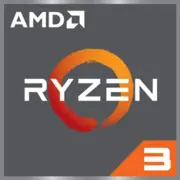AMD Ryzen 3 1300X

AMD Ryzen 3 1300X: A Budget Processor for Basic Tasks in 2025
Review for those looking for affordable performance
Key Features: Zen Architecture and Power Balance
The AMD Ryzen 3 1300X, released in 2017, remains a popular choice for budget builds due to its reliability and simplicity.
Architecture and Process Technology
- Codename: Summit Ridge
- Architecture: Zen (first generation)
- Process Technology: 14nm (GlobalFoundries)
With four physical cores and four threads (without SMT support), it offers basic multitasking capabilities. The base frequency is 3.5 GHz, with the potential to overclock to 3.9 GHz in Turbo mode. Despite its age, the processor remains relevant for light tasks, thanks to its unlocked multiplier, which is rare in the budget segment.
Performance
- Geekbench 6: 1095 (Single-Core), 3155 (Multi-Core)
- L3 Cache: 8 MB
- TDP: 65 W
In tests from 2025, the Ryzen 3 1300X shows modest results but handles office applications, browsing, and older games. For example, in CS:GO at medium settings (Full HD), it achieves 90-120 FPS when paired with a graphics card like the NVIDIA GTX 1650.
Key Features
- Overclocking: Even with the stock cooler, one can achieve stable operation at 3.8-4.0 GHz.
- Energy Efficiency: Low heat generation makes it easier to build into compact cases.
Compatible Motherboards: AM4 Socket and Chipset Options
The Ryzen 3 1300X uses the AM4 socket, which is supported by many motherboards, but new models are no longer being released as of 2025.
Recommended Chipsets
- B350/X370: For overclocking (e.g., ASUS Prime B350-Plus).
- A320: Budget option without overclocking support (e.g., Gigabyte GA-A320M-S2H).
Selection Features
- BIOS Update: Many boards require updates to work with Zen processors. Check the BIOS version before purchasing.
- Prices: New A320 boards range from $60–80, while B350/X370 boards are $80–120 (based on remaining stock).
Practical Example
A user from Brazil built a PC with the Ryzen 3 1300X and ASRock B450M-HDV (priced at $75) in 2024, updating the BIOS through USB Flashback. The system booted up on the first try.
Memory: DDR4 and Frequency Limitations
The Ryzen 3 1300X supports only DDR4.
Recommendations
- Frequency: Up to 2666 MHz on A320 chipsets and up to 3200 MHz on B350/X370 (with overclocking).
- Dual-Channel Mode: Use two sticks (e.g., 2x8 GB DDR4-2400) to boost performance.
Important
DDR5 is not supported, which limits future upgrades.
Power Supply: Minimum 450W
With a TDP of 65 W, the processor does not require a powerful PSU, but it's essential to consider other components.
Recommendations
- Without a discrete graphics card: 300–400 W (e.g., be quiet! Pure Power 11 400W).
- With a graphics card like the NVIDIA GTX 1660: 500 W (EVGA 500 BR).
Example
A build with the Ryzen 3 1300X, GTX 1650, and two SSDs consumes around 200 W under load. A 450 W unit would be sufficient.
Pros and Cons: Who Is It Relevant For in 2025?
Pros
- Price: $70–90 (for new units).
- Overclocking: Frequency increase provides a 10–15% performance boost.
- Compatibility: Supports Windows 10/11 and Linux.
Cons
- No SMT: Lags behind in multithreading compared to Ryzen 3 3100 (8 threads).
- Outdated Process Technology: 14 nm vs. 7 nm for Ryzen 5000.
Usage Scenarios: Gaming, Office, Media
- Gaming: GTA V, Fortnite, Dota 2 — medium settings, Full HD.
- Work: Office suites, browsers with 10+ tabs.
- Multimedia: Streaming video (4K via YouTube), light editing in Shotcut.
Real Case
A student from India built a PC with Ryzen 3 1300X and RX 570 for $300, playing Valorant at 100 FPS.
Comparison with Competitors
- Intel Core i3-7100 (7th generation): Better in single-core tasks (Geekbench 6 Single-Core ~1200), but more expensive ($90–100) and does not support overclocking.
- Ryzen 3 2200G: Integrated Vega 8 graphics, but a weaker CPU part (Geekbench 6 Multi-Core ~2900).
Assembly Tips
1. Cooler: The basic AMD Wraith Stealth is sufficient even for light overclocking.
2. Storage: Use an SSD (e.g., Kingston A400 480GB for $35).
3. Motherboard: Choose B450 for compatibility with future upgrades (e.g., to Ryzen 5 3600).
Conclusion: Who Should Consider the Ryzen 3 1300X?
This processor is a choice for:
- Budget Builds: When the goal is to minimize costs.
- Upgrading Old PCs: Replacing FX-6300 or Phenom II.
- Enthusiasts: Experimenting with overclocking on affordable hardware.
In 2025, the Ryzen 3 1300X is not a top performer, but it remains a reliable option for basic tasks. If the budget allows, it’s better to choose Ryzen 5 5500 ($130), but for simple scenarios, the 1300X is still relevant.
Basic
CPU Specifications
Memory Specifications
GPU Specifications
Miscellaneous
Benchmarks
Compared to Other CPU
Share in social media
Or Link To Us
<a href="https://cputronic.com/en/cpu/amd-ryzen-3-1300x" target="_blank">AMD Ryzen 3 1300X</a>